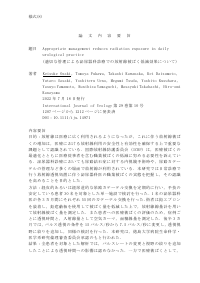Appropriate management reduces radiation exposure in daily urological practice
Total for the last 12 months
number of access : ? 件
number of downloads : ?
Use this link to cite this item : https://repo.lib.tokushima-u.ac.jp/118219
| ID | 118219 |
| Title Alternative | 適切な管理による泌尿器科診療での放射線被ばく低減効果について
Radiation exposure in daily urological practice
|
| Author |
Ozaki, Keisuke
Tokushima University
Fukawa, Tomoya
Tokushima University
Tokushima University Educator and Researcher Directory
KAKEN Search Researchers
Kawanaka, Takashi
Tokushima University
Tokushima University Educator and Researcher Directory
KAKEN Search Researchers
Daizumoto, Kei
Tokushima University
Tokushima University Educator and Researcher Directory
KAKEN Search Researchers
Ueno, Yoshiteru
Tokushima University
Kusuhara, Yoshito
Tokushima University
Tokushima University Educator and Researcher Directory
KAKEN Search Researchers
Yamamoto, Yasuyo
Tokushima University
Tokushima University Educator and Researcher Directory
KAKEN Search Researchers
Yamaguchi, Kunihisa
Tokushima University
Tokushima University Educator and Researcher Directory
KAKEN Search Researchers
|
| Keywords | radiation exposure
urologist
X-ray fluoroscopy
|
| Content Type |
Thesis or Dissertation
|
| Description | Objectives: To identify and raise awareness of the radiation exposure of urologists due to X-ray fluoroscopic procedures in daily practice.
Methods: This was a single-center, cohort study of 30 consecutive patients who underwent periodic percutaneous or transurethral replacements of urinary tract catheters. A total of 55 replacements every three months with cases aligned were performed by a single urologist. The urologist’s radiation exposure and the incident dose to patients per case were measured with thermoluminescent dosimeters. In the latter three-month period, the pulse fluoroscopy condition was changed from 15 to 7.5 pulses per second, and collimation was added to the field of view. Results: In the analysis of all patients, the use of a modified pulse rate and collimation did not affect the fluoroscopy time, but it did significantly reduce the air kerma and dose area product; in addition, with respect to the medical exposure dose during percutaneous catheter replacement, fluoroscopy time was longer, but air kerma and dose area product showed significant decreases. As with decreases in medical exposure of patients, the equivalent dose for eye lenses of the urologist decreased from 1.2 mSv in the first three-month period to 0.2 mSv in the second three-month period. Similarly, the exposure dose for the extremities also decreased significantly, from 33.9 mSv to 8.1 mSv. Conclusions: Urologists are exposed to non-negligible amounts of radiation due to fluoroscopy. Appropriate management such as Modified pulse fluoroscopy condition and precautions are required. |
| Journal Title |
International Journal of Urology
|
| ISSN | 09198172
14422042
|
| NCID | AA11042471
|
| Publisher | Wiley|Japanese Urological Association
|
| Volume | 29
|
| Issue | 10
|
| Start Page | 1207
|
| End Page | 1212
|
| Published Date | 2022-07-18
|
| Remark | 内容要旨・審査要旨・論文本文の公開
本論文は,著者Keisuke Ozakiの学位論文として提出され,学位審査・授与の対象となっている。 |
| Rights | This is the peer reviewed version of the following article: Ozaki, K., Fukawa, T., Kawanaka, T., Daizumoto, K., Sasaki, Y., Ueno, Y., Tsuda, M., Kusuhara, Y., Yamamoto, Y., Yamaguchi, K., Takahashi, M., Kanayama, H., (2022), Appropriate management reduces radiation exposure in daily urological practice. International Journal of Urology, 29, 10, 1207-1212., which has been published in final form at https://doi.org/10.1111/iju.14971. This article may be used for non-commercial purposes in accordance with Wiley Terms and Conditions for Use of Self-Archived Versions. This article may not be enhanced, enriched or otherwise transformed into a derivative work, without express permission from Wiley or by statutory rights under applicable legislation. Copyright notices must not be removed, obscured or modified. The article must be linked to Wiley’s version of record on Wiley Online Library and any embedding, framing or otherwise making available the article or pages thereof by third parties from platforms, services and websites other than Wiley Online Library must be prohibited.
|
| EDB ID | |
| DOI (Published Version) | |
| URL ( Publisher's Version ) | |
| FullText File | |
| language |
eng
|
| TextVersion |
ETD
|
| MEXT report number | 甲第3679号
|
| Diploma Number | 甲医第1563号
|
| Granted Date | 2023-02-24
|
| Degree Name |
Doctor of Medical Science
|
| Grantor |
Tokushima University
|
| departments |
Medical Sciences
University Hospital
|


